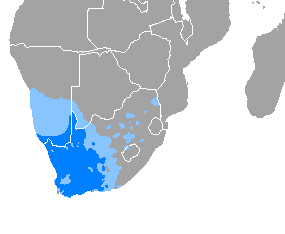
Afrikaans is a West Germanic language, spoken in South Africa, Namibia and Botswana, Zambia and Zimbabwe. Estimates of the number of Afrikaans speakers range between 15 and 23 million. It evolved in the Dutch colonization in southern Africa from the Dutch vernacular used by Dutch settlers and people enslaved by them. Afrikaans gradually began to develop distinguishing characteristics during the course of the 18th century.

Japanese traditional dance describes a number of Japanese dance styles with a long history and prescribed method of performance. Some of the oldest forms of traditional Japanese dance may be among those transmitted through the kagura tradition, or folk dances relating to food producing activities such as planting rice and fishing, including rain dances. There are large number of these traditional dances, which are often subfixed -odori, -asobi, and -mai, and may be specific to a region or village. Mai and odori are the two main groups of Japanese dances, and the term buyō (舞踊) was coined in modern times as a general term for dance, by combining mai (舞) and odori (踊).

Cape Coloureds are a South African ethnic classification consisting primarily of persons of mixed race African, Asian and European descent.
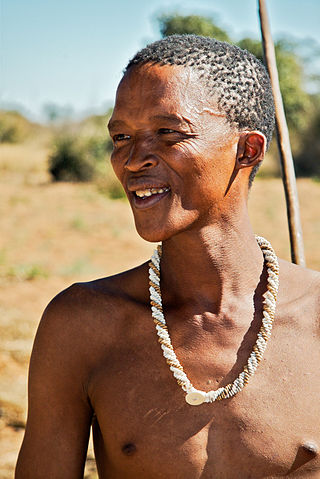
KhoisanKOY-sahn, or Khoe-Sān, is a catch-all term for the indigenous peoples of Southern Africa who traditionally speak non-Bantu languages, combining the Khoekhoen and the Sān peoples. Khoisan populations traditionally speak click languages and are considered to be the historical communities throughout Southern Africa, remaining predominant until European colonisation in areas climatically unfavorable to Bantu (sorghum-based) agriculture, such as the Cape region, through to Namibia, where Khoekhoe populations of Nama and Damara people are prevalent groups, and Botswana. Considerable mingling with Bantu-speaking groups is evidenced by prevalence of click phonemes in many especially Xhosa Southern African Bantu languages.

Coloureds refers to members of multiracial ethnic communities in South Africa who may have ancestry from African, European, and Asian people. The intermixing of different races began in the Cape province of South Africa, with Dutch settlers, African and Malaysian slaves intermixing with the indigenous Khoi tribes of that region. Later various other European nationals also contributed to the growing mixed race people, who would later be officially classified as coloured by the apartheid government in the 1950s.

Khoekhoe or KHOI as known today are the traditionally nomadic pastoralist indigenous population of South Africa. They are often grouped with the hunter-gatherer San peoples. The designation "Khoekhoe" is actually a kare or praise address, not an ethnic endonym, but it has been used in the literature as an ethnic term for Khoe-speaking peoples of Southern Africa, particularly pastoralist groups, such as the !Ora, !Gona, Nama, Xiri and ǂNūkhoe nations.

The San peoples, or Bushmen, are the members of the indigenous hunter-gatherer cultures of southern Africa, and the oldest surviving cultures of the region. Their recent ancestral territories span Botswana, Namibia, Angola, Zambia, Zimbabwe, Lesotho and South Africa. They speak, or their ancestors spoke, languages of the Khoe, Tuu and Kxʼa language families, and are seen by outsiders as a people only in contrast to neighboring pastoralists such as the Khoekhoe and descendants of more recent waves of immigration such as the Bantu, Europeans and Asians.

The Griquas is a subgroup of mixed race heterogeneous former Khoe-speaking nations in Southern Africa with a unique origin in the early history of the Dutch Cape Colony. Under apartheid, they were given a special racial people classification under the broader category of "Coloured". They are Cape Coloureds who participated in the Great Trek, forming "Griqua States".

The Basters are a Southern African ethnic group descended from Cape Coloureds and Nama of Khoisan origin. Since the second half of the 19th century, the Rehoboth Baster community has been concentrated in central Namibia, in and around the town of Rehoboth. Basters are closely related to Afrikaners, Cape Coloureds, and Griquas of South Africa and Namibia, with whom they share a language and culture. They are also related to the local Nama, with the Rehoboth Basters being considered a Nama clan by many, having a "Kaptein" just like many Nama settlements in Southern Namibia.

Romvong, Lamvong or Ramwong, Rambung, Vietnamese: lăm-vông) is a type of Southeast Asian dance where both females and males dance in a circle. It is a popular folk-dance in Xishuangbanna (China), Cambodia, Laos, Malaysia and Thailand. It is a slow round dance continuously moving in a circular manner, and incorporates graceful hand movements and simple footwork. Both men and women participate in the same circle.

South African cuisine reflects the diverse range of culinary traditions embodied by the various communities that inhabit the country. Among the indigenous peoples of South Africa, the Khoisan foraged over 300 species of edible food plants, such as the rooibos shrub legume, whose culinary value continues to exert a salient influence on South African cuisine. Subsequent encounters with Bantu pastoralists facilitated the emergence of cultivated crops and domestic cattle, which supplemented traditional Khoisan techniques of meat preservation. In addition, Bantu-speaking communities forged an extensive repertoire of culinary ingredients and dishes, many of which are still consumed today in traditional settlements and urban entrepôts alike.
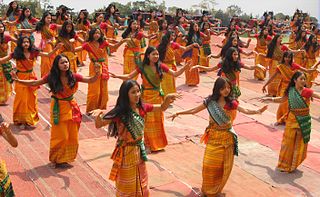
The Bagurumba is a traditional dance of the indigenous Boro people living in the State of Assam and North East India. It is also called '''butterfly dance''' because it's personification of movements of butterflies and birds. In this occasion, only the Bodo women perform the dance, wearing their colourful traditional attire dokhna, jwmgra (fasra) and aronai. The dance is accompanied by handmade percussion instruments such as 'kham', sifung, jota, serja, and gongwna, tharkha.

Williston is a town in Northern Cape, South Africa. Town 103 km north-east of Calvinia and 140 km south-west of Carnarvon.

Calvinia is a regional town in the Northern Cape province of South Africa named after the French religious reformer Jean Calvin. The town falls under the Hantam Local Municipality which forms part of the Namakwa District Municipality. The Calvinia district is part of the Great Karoo region of South Africa. The town is just south of the Hantam mountains on the banks of the Oorlogskloof River.

Folk dance of Mexico, commonly known as baile folklorico or Mexican ballet folk dance, is a term used to collectively describe traditional Mexican folk dances. Ballet folklórico is not just one type of dance; it encompasses each region's traditional dance that has been influenced by their local folklore and has been entwined with ballet characteristics to be made into a theatrical production. Each dance represents a different region in Mexico illustrated through their different zapateado, footwork, having differing stomps or heel toe points, and choreography that imitates animals from their region such as horses, iguanas, and vultures.
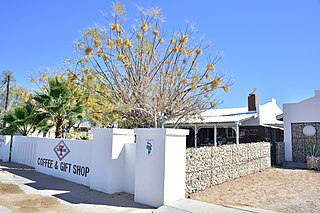
Askham is a village in the Dawid Kruiper Local Municipality in the ZF Mgcawu District Municipality in the Northern Cape province of South Africa. Askham lies not far from the confluence of the mostly dry Molopo and Kuruman Rivers in the Red Kalahari Desert, about 200 km north of Upington at the junction of the R31 and the R360 roads.
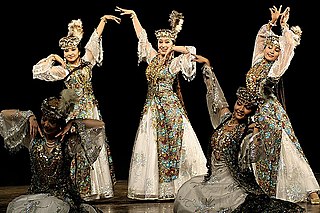
There are three schools of dance in Uzbekistan: Khorezm, Fergana, and Bukhara. Each one has its peculiarities and specific features.

Stephen Michael Fritz is a Khoi leader born in South Africa on 4 March 1970. He is a South African indigenous and traditional leader and Senior Chief of the South Peninsula Khoi Council, which is based in the Western Cape of South Africa. He is a well-known environmentalist and public speaker. He is an expert in the use of plants for medicinal purposes and he is a qualified indigenous guide and wildlife conservationist. He is also an activist for the rights of the indigenous people of South Africa. Chief Fritz is a founding member of the Pro Elephant Network and member of the Wildlife Animal Protection Forum South Africa.
The Kuru Dance and Music festival is an annual celebration included in the Botswana's calendar of events marking the full moon where Khoisan communities find it very significant in their culture to interchange cultural knowledge through song and dance.
Khoisan revivalism is the phenomenon of individuals claiming to be Khoisan (descendants) and defending indigenous rights. The Khoisan revival movement aims to confirm and demarginalize the cultural identity of the Khoisan in modern-day South Africa. Khoisan revival is most active and likely to impact policy-making in Cape Town, in the Western Cape province of South Africa. The Koranna, Nama, San, Griqua, and Cape Khoi are among the Khoisan revivalist groups of the Western Cape.

















